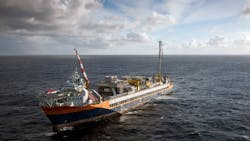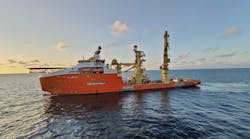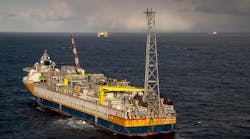Inquest identifies failings over wave ingress at Åsgard A FPSO
Equinor must respond to an investigation conducted by the Norwegian Ocean Industry Authority (Havtil) into an incident onboard the Åsgard A production vessel in the Norwegian Sea last January.
During a heavy storm, a large wave (green water) struck the platform. The pressure from the wave exceeded the load resistance of one cabin window, leading to both the window and window frame being forced into the cabin.
There was damage to the inside and outside of the cabin, with large volumes of seawater surging into the living quarters. Had staff been present in the cabin, there could have been a serious injury or fatality.
The investigation has identified the following underlying causes: the location of the emergency escape shaft; design and execution of the window fixing; lack of protection for cabin windows; insufficient green water model tests; and follow-up of observations.
Non-conformities identified included inadequate assessments for green water; a lack of compliance with internal requirements for covering of cabin windows; and weakened load resistance of cabin windows.
Another factor was also observed that has been categorized as an improvement point. This concerned wave measurements and meteorological observations.
Havtil has asked Equinor to identify measures and draw up a plan for implementing these by February 2028.
Last week, Havtil presented its safety status for the Norwegian Continental Shelf for 2024, and its expectations for the industry in 2025. Director general Anne Myhrvold said in 2024 fires had been reported offshore in switchrooms and separators.
There were three cases of decompression sickness from diving, the first such incidents since the 1990s, and other reports of crush injuries and falling objects.
Myhrvold also touched on artificial intelligence (AI)-based solutions as a way of reducing risk.
“But AI can also do the opposite and contribute to increased risk…," she said. “Safe and prudent use must rest on an interplay between people, technology and organizations, and we must prevent AI from making us more vulnerable to external threats and malicious actions.
“Another important task in 2025 is for the industry to develop standards in order to provide guidance on the safe use of AI. Responsible use of AI is a shared concern for all industry stakeholders, but ultimately it is a managerial responsibility.”
Bjørn Thomas Bache, director of supervisory activities at Havtil, also note various incidents last year involving electrical systems.
“Some of these may be linked to deficiencies in the maintenance program, such as a lack of systematic prevention and monitoring of the technical condition of electrical equipment," he said. “We also see examples of certain companies having an inadequate overview of weakened barrier elements and barrier functions…”
Finn Carlsen, director of professional competence, added, “There is also a high level of activity in drilling and wells. Havtil has pointed to the need for improvement of well control and in particular the operators’ handling of information on pore pressure.
“This will also be a priority area in 2025.”
Carlsen also highlighted the changing security policy picture and threat level in Norway. “Norway’s deliveries of gas to Europe are essential for their energy security," he said. “Havtil is therefore intently focused on the handling of critical infrastructure and security-threatening maritime activities.”


